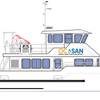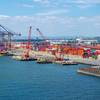The fresh fruits and vegetables on your family table may be from the farms of Portugal, having made the six-day trip across the ocean in refrigerated containerships from Lisbon to the States. And nearly 2,000 passengers recently steamed into Venice aboard the Grand Princess, which, running the length of two and a half football fields, is the largest cruise ship in the world. About 90 percent of its passengers that day, as is the case every day on most cruise ships, were Americans.
In Pennsylvania, hundreds of our products - among them Cannondale bikes, Cove shoes, JLG lifts, Freedom Forge Wheels, Letterkenny ammunition, and Empire chickens - travel by rail or truck to our ocean ports for shipment across the oceans of the world.
With the growth of the global economy, coupled with better transportation systems, the hills and valleys of central Pennsylvania are as close today to Europe and the Far East as Pittsburgh was to Philadelphia a hundred years ago. Pennsylvania is now ocean-shipping $5.3 billion annually around the world. Most of it in 20- or 40-ft. containers on giant ocean ships. The U.S. container trade has nearly tripled in the past 20 years from 48 to 137 million tons, and is projected to more than double again in the next 20 years.
Thousands of Americans now depend on that trade. Our prosperity is tied to our ability to transport our products effectively and economically to their destinations. Our maritime transportation system moves over two billion tons of foreign and domestic cargo annually, contributing $742 billion to our economy, and generating 13 million jobs.
The great containerships of the world each carry over 6,000 20-ft. truck-like containers, requiring ports with depths of about 50 ft. Yet six of America's largest container ports, which handle 80 percent of U.S. container traffic, do not have depths that great. They cannot handle the giant ships, which are increasingly diverting to ports in Nova Scotia, Canada and the Bahamas. Our harbors need to be dredged, and our terminals and intermodal connections to trucks and rails need to be modernized. Not only are American port jobs in jeopardy, but the increased cost of shipping U.S. products overseas puts all our export-related jobs at risk.
The good news is that a Harbor Maintenance Trust Fund already exists, receiving fees from users. The bad news is that, while it has collected about $733 million annually, it has spent only about $500 million each year, leaving a balance of $1.3 billion. Instead of investing at the level the Trust Fund can support, much of the money is withheld to offset unrelated government spending. Further compounding the problem, the Supreme Court has ruled a portion of the fees unconstitutional. We must both unlock the fund and restructure it to pass constitutional muster so it can be used to modernize our maritime infrastructure.
Likewise, the products flowing through our inland waterways - our rivers, lakes and canals - many on their way to loaded onto ocean carriers for shipment overseas, suffer from both our outdated ports and harbors and an antiquated system of locks and canals.
Barges move 800 million tons of cargo on these waterways each year, representing 15 percent of the nation's freight for less than two percent of the nation's total freight cost. Yet, over half of the 270 locks making navigation possible are antiquated, well beyond their 50-year design lives. A 15-barge grain tow moves the equivalent of 870 trucks or 255 railroad cars, but because of outmoded locks, must be broken apart to pass in smaller clusters, raising the cost of shipping and slowing deliveries.
Without modern navigation systems - such as electronic charting and transponders - the vessels on our inland waterways are needlessly unsafe. If the fog-blinded tow that hit a bridge, causing an Amtrak train to plunge into the Mobile River in 1993, killing 47 people, had had modern navigational equipment, the tragic accident could have been avoided.
Again, the good news is that an Inland Waterways Trust Fund, paid into by the users, already exists to help modernize the system. But it is not being spent for its intended purpose. Last year, the fund invested only $77 million, about 25 percent of the $304 million available, for improving the 25,600 miles of our inland and coastal waterways.
Just as we have unlocked the Highway Trust Fund to invest the money paid into it to improve American highways and transit systems, and as the U.S. House this year has overwhelmingly passes legislation to unlock the Aviation Trust Fund, it is time to begin the battle to rededicate our harbors and inland waterways trust funds so they, too, can be used for their intended purpose to help rebuild the nation's maritime and river systems. -- (By Congressman Bud Shuster,U.S. House Transportation And Infrastructure Committee Chairman)
Congressman Shuster recently led a delegation to inspect ocean shipping and shipbuilding facilities in Italy, Greece, Spain, and Portugal. His article is based, in part, on knowledge gained on that trip.
Sponsored Content
Lower carbon intensity fuels to support your operations

Subscribe for
Maritime Reporter E-News
Maritime Reporter E-News is the maritime industry's largest circulation and most authoritative ENews Service, delivered to your Email five times per week










